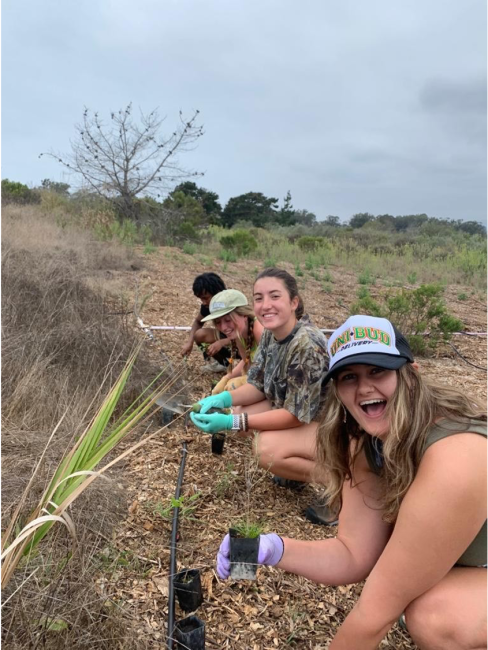
ELI students, Shannon Carew and Fiona Jeweler, get their hands dirty, bringing native plants to the North Campus Open Space to restore the site to help declining bat populations.
When you think of a healthy natural ecosystem, of plants and pollinators, flowers and worms, you probably aren’t thinking of bats. Bats are an often overlooked but crucial component of ecosystems globally, including here in Santa Barbara. One of bats most notable attributes is their nocturnal pollination, which makes possible the pollination of flowers that their diurnal counterparts can’t get to–including important crops such as dates, figs, mangoes, and peaches. Bats also provide seed dispersal and fertilizer in the form of guano, further improving soil and ecosystem health. They feed on nocturnal insects, keeping their populations in check and mitigating agricultural pests. Bats give us a lot to be grateful for!
Unfortunately, bat populations are in a steep decline. “This dire situation is greatly unknown to many so we wanted to do something that would both promote bat health and educate people on the status of their population levels,” says Shannon Carew (Environmental Studies, 3rd year), a UCSB ELI student. In comes UC More Bats: an ecological restoration project aimed to bring a healthy bat population to campus, through the installation of native plants that attract insects bats feed on.
“We were able to plant just over 200 plants at a site in North Campus Open Space, working with the help of the Cheadle Center for Biodiversity and Ecological Restoration (CCBER), specifically Lisa Stratton and Darwin Richardson. These plants were picked because of their ability to attract moths and other important insects in bats’ diets,” explains Fiona Jeweler (Environmental Studies, 3rd year). “The site was also perfect because of a dead tree located on site. Dead trees are useful because bats utilize them as roosting sites!” What also makes this project so special is that the plants are native and biologically distinct. While the intent is to attract bats, the installed flora has the additional benefits of attracting native insects and birds, and occupies an important ecological niche that replaces the invasive species there previously.
Students admiring the completed garden.
Fiona and Shannon were able to complete this project with the help of ELI, CCBER, and their mentors. “We really enjoyed being outside and connecting with so many experts in the restoration field. Sometimes climate news can become a lot to deal with so being able to do something small yet impactful felt very empowering… Courtesy of Darwin and our mentor Monique O’Conner, we learned all the ins and outs of a restoration garden!” they explain.
The bat garden can be found on the North Campus Open Space. A list of the plants installed, and more information about bats, can be found here.